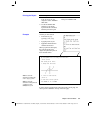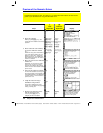
Chapter 19: Numeric Solver 335
19SOLVER.DOC TI-89/TI-92 Plus: Numeric Solver (English) Susan Gullord Revised: 02/23/01 1:16 PM Printed: 02/23/01 2:19 PM Page 335 of 10
To display the Numeric Solver, press
O
9.
The Numeric Solver screen shows the
last entered equation, if any.
On the
eqn:
line, type in your
equation.
You can: For example:
Type an equation
directly.
a=(m2
ì
m1)/(m2+m1)
ù
g
a+b=c+sin(d)
Refer to a function or
equation defined
elsewhere.
Suppose you defined
y1(x)
on either the:
¦
Y= Editor:
y1(x)=1.25x
ù
cos(x)
– or –
¦ Home screen:
Define y1(x)=1.25x
ù
cos(x)
In the Numeric Solver, you then would enter:
y1(x)=0
or
y1(t)=0, etc.
Type an expression
without an = sign.
e+f
ì
ln(g)
After you press
¸
, the expression is set
equal to a system variable called
exp
and
entered as:
exp=e+f
ì
ln(g)
Recall a previously
entered equation or
open a saved
equation.
Refer to the applicable heading later in this
section.
Displaying the Solver and Entering an Equation
After you display the Numeric Solver, start by entering the
equation that you want to solve.
Displaying the
Numeric Solver
Entering an
Equation
Tips: In your equation:
• Do not use system
function names
(such as
y1(x) or
r1(
q
))
as simple
variables
(y1 or
r1)
.
• Be careful with implied
multiplication. For
example,
a(m2+m1)
is
treated as a function
reference, not as
a
ù
(m2+m1)
.
Note: When you define the
variables, you can either
define
exp
or solve for it.
Note: After you press
¸
the current equation is
stored automatically to the
system variable
eqn
.
The argument does not have to
match the one used to define the
function or equation.


















